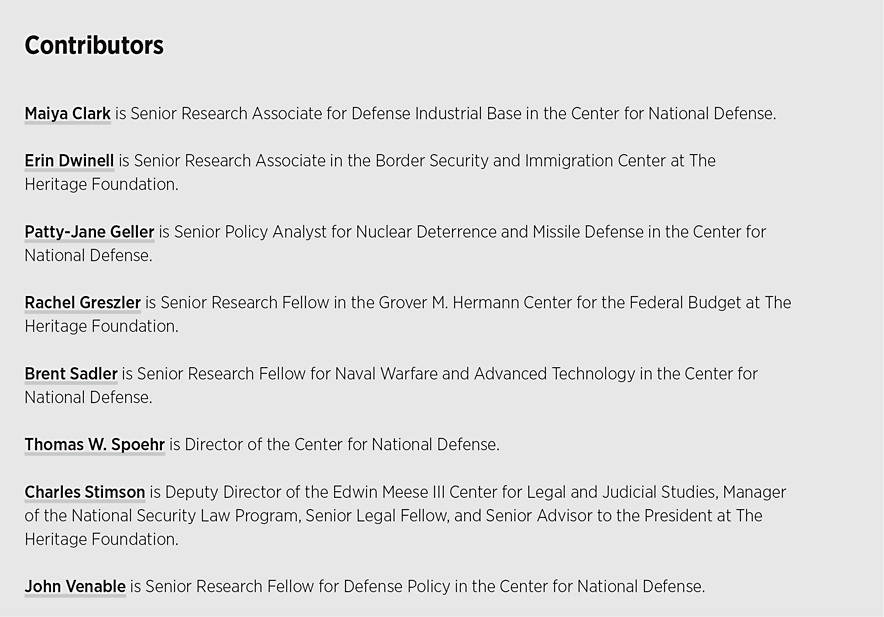The contents of both the House and Senate versions of the National Defense Authorization Act (NDAA) for fiscal year (FY) 2023 suggests that Members of Congress can still work together to improve the national defense, and that there is a strong constituency for peace through strength.REF On July 14, the House passed its version of the NDAA with ample bipartisan support of 329 to 101.REF On June 16, the Senate passed its version out of committee with 23 votes in favor and three against, bringing the bill closer to being considered in conference by the full chamber.REF
As with many bipartisan pieces of defense legislation, some provisions would be detrimental to the national defense and should be removed, and some proposals put forward by one chamber should be adopted by the other in conference. This Backgrounder highlights some of the most-needed changes.
Both versions of the legislation largely represent a rejection of the Biden Administration’s budget request for the Department of Defense (DOD), both of the proposed funding and of the proposed divestments of useful military platforms.REF The Biden Administration proposed a defense budget that would decrease the resources available to the Pentagon after accounting for the effects of inflation. In a repetition of last year, Congress rejected President Biden’s budget request and once again appropriately chose to authorize more resources for the national defense.REF Congress even explicitly reserved resources to be used to blunt the impacts of inflation. The House authorized more than $7 billion, and the Senate authorized $20 billion, to be distributed to different programs to ameliorate the impact of inflation.REF
When it comes to capacity, this NDAA departs from President Biden’s proposals to retire existing platforms now in order to free up funding to pursue newer platforms that would be deployable in seven to 10 years. Congress properly rejected most of the proposed system retirements, from the Littoral Combat Ships to the B83 nuclear bomb. Congress seems to understand that to cut existing systems without immediate replacements is an unacceptable risk.
Recommendations for Finalizing the FY 2023 NDAA
Before a conference committee can address the differences between the two versions of the NDAA, the Senate must pass its version of the bill. In the previous fiscal year, the Senate could not find floor time to consider the NDAA, which created a considerable delay in the passage of the legislation, pushing its passage to the very end of the year, far past the start of the fiscal year.REF The Senate should make time earlier in the year, so a new NDAA is in effect before the start of the new fiscal year.
Once the bill passes the Senate and Congress meets in conference to settle the differences between the two versions of the NDAA, Congress should:
Reject the Expansion of the Selective Service System. The Senate has a provision that would expand the Selective Service and require that women register for it.REF That would be a misguided expansion of a system that should be dismantled and rethought. The likelihood of the Selective Service being used to increase the ranks of the Armed Forces is zero, and the system as currently constructed detracts from military readiness. The best path forward is to drop the expansion of the Selective Service and focus on provisions that, in fact, improve military readiness.REF
Support the Repeal of the 1991 and 2002 Authorizations to Use Military Force (AUMF) and Leave the 2001 AUMF in Place. The 1991 and 2002 AUMF Against Iraq Resolutions remain in force even though their purpose has been accomplished. Repealing them would not affect the 2001 AUMF, the primary domestic statutory authority for prosecution of the war against al-Qaeda, the Taliban, ISIS, or associated forces.REF The House version of the NDAA includes a provision to repeal the 1991 and 2002 AUMFs. This language should be adopted in conference. Although it is not in the NDAA, the House Appropriations Committee included a provision in its defense appropriations bill to sunset the 2001 AUMF. Without this authority, the Administration would lose its ability to conduct counter-terror operations overseas. This provision should not be supported in any legislative package.
Strengthen Shipbuilding Procurement. Both the Senate and House proposals have merits and shortcomings. The best of both should be in the final version. The conference should settle on a procurement of no fewer than 13 ships as listed in the House proposal, over the Senate’s eight. The conference should authorize the purchase of three destroyers, two nuclear submarines, two frigates, one amphibious transport, two oilers, two medical ships, and one salvage and rescue ship, as outlined by the House bill. Unlike the House version of the bill, the Senate version would forgo the procurement of one destroyer, one frigate, one oiler, and two medical ships. These ships would be of great utility to the Navy especially in deterring Chinese aggression.REF Additionally, the Senate’s proposed authorization for a 33-ship block purchase over an extended period would make shipbuilding more efficient and predictable, leading to the necessary growth in needed industrial capacity to build warships.
Congress should broaden the House language to refuse the decommissioning of any ship until the Navy has a replacement. While the House has put seven ship retirements on hold, other ships could still be decommissioned. These proposed decommissionings have largely been driven by operational cost savings, not operational needs. A conditional hold on future retirements can staunch the rapid reduction of the Navy’s fleet, but it must be matched with associated operational funding to keep older ships in service till a replacement is received. In the absence of this, the House has a better position, and both chambers should support its prohibitions on specific ship decommissionings.
Continue to Fund Rebuilding of Public Shipyards. The Navy needs its four public shipyards to maintain nuclear submarines and aircraft carriers on schedule, but the shipyards suffer from decades of underinvestment. They have too few functional dry docks, and their facilities and capital equipment are old and poorly configured. These issues have caused maintenance backlogs across the nuclear fleet, and the Navy predicts that 68 maintenance availabilities—the period when a ship is not employable due to scheduled maintenance—will be missed if the shipyards’ problems are not remedied.REF The Navy’s Shipyard Infrastructure Optimization Plan (SIOP) is the best plan to address decades of infrastructure neglect at the four shipyards.REF Congress should continue to fully fund the SIOP and should make the reconstruction of Navy shipyards a top priority.
Congress should also require the Navy to revise its cost estimates and schedule goals to reflect its true progress (or lack thereof) on the SIOP since its beginning in 2018. The Government Accountability Office (GAO) reported that the cost of dry dock projects has already doubled since 2018 and will continue to grow, while key schedule milestones have been missed.REF The final NDAA should reflect the language in the Senate bill, which requires the Navy to address the problems described in the GAO report.
Increase Funding for the National Defense Stockpile (NDS) and Update the NDS for the New Era of Great-Power Competition. The NDS is a crucial resource meant to provide manufacturers with secure access to raw materials needed for essential defense goods and services.REF Having this “insurance” against defense supply-chain disruptions is crucial, given U.S. reliance on China for many raw materials. However, the stockpile has shrunk over the past three decades. The NDS does not receive annual appropriations in the defense budget—neither for new purchases of materials nor for operations expenses. Instead, the stockpile depends on a revolving fund in the U.S. Treasury called the National Defense Stockpile Transaction Fund.REF
Now, Congress must infuse the NDS with funding so it can function properly and acquire and maintain the necessary stocks of materials. The final NDAA should reflect the language in the Senate version of the bill, which includes an authorization of $1 billion for the National Defense Stockpile Transaction Fund to acquire strategic and critical minerals currently in shortfall—effectively doubling the value of the stockpile. It should also update the operating practices of the NDS, allowing the stockpile’s manager more flexibility in acquiring new materials.REF
Prioritize Replenishment of Munitions Stocks—and Require the Military Services to Do the Same. The war in Ukraine quickly consumed approximately a third of U.S. stocks of certain key munitions, indicating that these stocks were never large enough to meet wartime needs. The military services prefer to buy platforms—tanks, ships, and planes—rather than the missiles and munitions that these systems launch. The assumption seems to be that, if the U.S. ever does go to war, it can quickly ramp up production of munitions to meet the military’s needs. However, those assumptions have proven to be wrong. It takes months and even years for production to ramp up. For example, American industry can produce about 80,000 155-millimeter artillery shells per year—which is what Ukraine currently expends in two weeks.REF
Seeking to address these problems, the House version of the NDAA increases funding to rebuild U.S. supply of essential munitions. The House bill also directs the DOD to implement a “new initiative to develop and invest in technologies to reduce the cost, increase reliability, enhance lethality, and diversify the supply chain for key munitions.”REF The Senate version of the bill adds more than $3 billion to critical munitions production and future expansion of capacity. The Senate also included a reporting framework that will help to guide future decisions on munitions.REF Congress should prioritize replenishing the munitions consumed in the Ukraine war. It should also implement the House bill’s provision requiring the services to explain their munitions requirements process and establish a critical munitions reserve.
Keep the House Provision that Mandates that the Air Force Maintain a Total Aircraft Inventory of 186 F-22 Fighters.REF The F-22 is the most dominant air-to-air fighter in the world, and it is one of the youngest fleets in the Air Force. With the pending retirement of the F-15C, the F-22 will be the only fighter that is dedicated to this role and any decision to retire it would prioritize cost over capability.REF The Senate bill contains similar language, but the House language is clearer, and the conference should adopt the House language.REF
Remove the House Provision that Prohibits the Availability of Funds for the Procurement of the Bridge Tanker Aircraft.REF The KC-X acquisition program delivered the KC-46 aircraft, which has stumbled badly throughout its development and fielding. The aircraft’s planned initial operating capability (IOC) date and full-rate production has slipped to FY 2024 or beyond due to remaining deficiencies with the boom system and Remote Vision System, and there is no guarantee that the fix for the Remote Vision System and the boom will allow the aircraft to reach its IOC within the expected timeline.REF The Air Force should open the Bridge Tanker contract to competition now to ensure that the procurement of modern, fully capable replacement tankers continues without interruption.
Keep the Senate Provision that Prohibits the Use of Funds to Retire the B83 Gravity Bomb. The B83 gravity bomb is currently the best warhead in the U.S. stockpile that is capable of holding at risk hard and deeply buried targets.REF Yet, the Biden Administration’s budget request would eliminate funding for the B83 life-extension program to keep the bomb in the stockpile beyond its planned retirement date, and both the Senate and House versions of the NDAA support this elimination of funds. The Senate bill would at least prohibit retirement of the B83 until the DOD submits a report on an alternative plan for holding at risk hard and deeply buried targets in the future. This capability is especially important as adversaries improve their hardening and tunneling capabilities over time to protect critical assets, such as command-and-control nodes. The final conference bill should keep this provision.
Add Funds to the Army’s Modernization Program. The House version of the NDAA adds funding to Army modernization accounts for the CH-47F, AH-64E, THAAD interceptors, Patriot Launchers, AMPV, Stryker, Paladin, Stryker, and Abrams programs. The Senate version only adds funds to the Abrams and Paladin programs. Modernization funding for the Army has seen a drastic cut under this Administration, and given these cuts, many Army modernization programs will now take decades to reach their acquisition objectives.REF The House version, which helps to accelerate Army modernization, should prevail in conference.
Keep the Senate Provision that Would Require a Funding Plan for the Acquisition of No Fewer than 64 Next-Generation Interceptors (NGIs). The DOD currently plans to buy 20 NGIs to add to the existing fleet of 44 ground-based interceptors (GBIs) to defend the homeland from ballistic missiles. This Senate provision would support an eventual procurement of 64 NGIs to replace the entire existing fleet of GBIs and to create a uniform fleet of interceptors. Since the NGI will have significant additional capability compared to the existing GBIs, an eventual uniform NGI fleet will be better equipped to address the increasingly larger and more sophisticated ballistic missile threat to the homeland.REF
Remove the House Amendment that Prohibits the Sale of New F-16s, F-16 Upgrade Kits, or Modernization Technology to Turkey. Were this prohibition to become law, it would become the second major arms constraint the U.S. has placed on Turkey over the past three years. In 2019, Turkey was removed from the F-35 program due to concerns over its purchase of the Russian S-400 missile system and the potential for that system’s radars to compromise the stealth technology of the F-35.REF
Turkey is a long-standing ally of the United States and member of the North Atlantic Treaty Organization. In that role, it has actively, and successfully, intervened to convince the Russian government to lift the blockade of Ukrainian ports and allow Ukraine to export its grain to the world, which reduced pressure on food prices. Prohibiting Turkey from buying new F-16s or even upgrading its current fleet would likely force Turkey to turn to Russia, or other providers, to refit its fleet of fighters.
Remove Immigration Age-Out Protections from the Final Bill. The “immigration age-out protections” in the House version of the NDAA have nothing to do with national defense and would encourage an even greater strain on the border and on the nation’s immigration system.REF It circumvents the law as intended, eliminating long-standing restrictions on temporary visas and immigration benefits. With illegal immigration at the border entirely out of control and 8.5 million cases backlogged or pending at the U.S. Citizenship and Immigration Services, Congress should not waste time by expanding eligibility for H-4 (temporary, nonimmigrant) visas.
This provision would set a dangerous precedent, as it is effectively a backdoor amnesty. It would transform the age, dependence status, and case filing dates into legal fictions, erasing any sort of barrier to permanent adjustment of status. Once such legally baseless precedents are set, the impact would extend far beyond the original category. If this provision were to become law, advocates will use it to call for the expansion of age-out requirements for any and every category of visas and immigration benefits.
Remove the House Provision that Prohibits Schedule F Reforms for Government Workers. Prohibiting Schedule FREF reforms is outside the proper scope of the defense authorization bill and should be removed in conference. Congress should not tie the hands of the Administration in responding promptly and effectively to America’s needs, especially when it comes to national security. Executive branch appointees should not be prevented from disciplining or dismissing federal employees who intentionally thwart their leaders’ initiatives. For example, presidential Administrations should have the authority to create a new schedule for federal workers who hold critical policy-related positions with the power to significantly affect Americans’ lives and to require that workers in that schedule no longer be immune from accountability as is the norm today, according to federal employees’ own reports.REF
Drop the Amendment that Would Prohibit Service Members from Providing Public Testimony. The House version of the NDAA contains an amendment, proposed by Representative Adam Schiff (D–CA) that, if passed, would prohibit the admission of any information obtained by, or with the assistance of, a member of the Armed Forces that violates the Posse Comitatus Act into evidence in virtually any judicial proceeding. This provision, if adopted, would prohibit the airing of a violation of the act in any trial, a hearing, any court, grand jury, department, officer, agency, regulatory body, legislative committee, or any other authority of the United States.
Styled by Representative Schiff as merely an amendment to strengthen the Posse Comitatus Act and prevent the U.S. military from being used inappropriately in domestic law enforcement functions, the amendment would do no such thing. Instead, as written, the amendment would cover up any violation of the act. If Representative Schiff wants to clarify that the act applies not only to members of the Army and Navy, but also to members of the Marines, Air Force, and Space Force, as well as members of the federalized National Guard and reserve components, he should go back to the drawing board and simply add an amendment so stating. As written, this amendment should be dropped in conference.
Reject the Transfer of Control of the District of Columbia National Guard to the Mayor. An amendment in the House version of the NDAA would transfer operational control of the DC National Guard to the mayor of Washington, DC. Due to the multiple overlapping lines of responsibility involved in protecting elements of the federal government located in the District of Columbia—the DOD, the Department of Homeland Security, the Treasury, the DC police, the Department of Justice, and others—it is impractical and sub-optimal for the mayor, who has a limited perspective of the different actors involved, to exercise operational control of the DC National Guard. There is no such provision in the Senate version. Congress should eliminate the House provision.
Reject Spurious Provisions to Foster Corporate Wokeness. The House bill has a provision that would require public companies to annually disclose the racial, ethnic, gender identity, sexual orientation, and veteran status of their board directors, nominees, and senior executive officers; it also creates an advisory group that would study and report on increasing corporate diversity. Aside from the obvious question of how such a provision was determined as appropriate for inclusion in a defense policy bill, the larger issue is that this requirement has no place in U.S. corporate governance. This reporting requirement will likely, over time, result in social pressure to pick unqualified board members. Board members should be selected on the basis of experience, temperament, and character, not sexual orientation or gender.
Conclusion
The NDAA under consideration by Congress is a good, albeit imperfect, bill. Congress has proposed to stop some of the capacity reductions proposed by the Biden Administration, but a considerable capacity gap remains, which The Heritage Foundation’s Index of U.S. Military Strength has consistently identified since its inaugural edition in 2015.REF
China’s growing aggressiveness combined with Russia’s brutal, illegal, and immoral war against Ukraine highlights the perils that the U.S. Armed Forces will face in the coming years.REF America’s adversaries see a window of opportunity to act, and the U.S. must build its deterrence posture with a ready, capable, and modern military.REF Congress must play its role by reinforcing U.S. deterrence and strengthening the national defense through the NDAA.
Frederico Bartels is Senior Policy Analyst for Defense Budgeting in the Center for National Defense at The Heritage Foundation.







